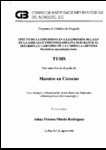Efecto de la espermina en la expresión del gen de la amilasa e inmunoglobina M durante el desarrollo larvario de la cabrilla arenera Paralabrax maculatofasciatus
Texto completo PDF:
Fecha
2005Autor
Olalde Rodríguez, Alicia Mónica
Metadatos
Mostrar el registro completo del ítemResumen
Large-scale egg production of marine fish has been a bottleneck in aquaculture systems. Low survival rates in rearing systems are associated with the incapacity of the larvae to adapt to the feeding sequence during the first weeks of culture (Kolkovsky et al., 1997). The change from endogenous to exogenous digestion is concomitant with the morphological and functional transformations of the digestive tract in larvae. Previous reports indicate that some components of the artificial diets, as well as live prey, regulate some digestive enzyme genes. Low levels of some cytosolic enzymes, associated with an increase in enzymes of the brush border membranes, dictates enterocyte maturation in mammals and fish. Contrary to the increasing information on digestive enzymes as maturation digestive indicators, this is the first report which considers the immunoglobulin M as a maturation parameter in marine fish larvae
Eggs were obtained from natural spawns of spotted sand bass broodstock maintained under controlled conditions in the Laboratory of Experimental Biology at CICIMAR-IPN (Rosales-Velázquez, 1997). The larvae were reared in a closed recirculating system. Microalgae Nannochloropsis oculata (300 000 cells.ml-1) was added until 12 dah. Larvae were fed rotifers Brachionus plicatillis (1-10 rotifers. ml-1) from 2-15dah, with Artemia sp. nauplii after 15dah, and juveniles (2-6 nauplii ml-1) as a control treatment. Three types of microcapsules were supplied as experimental treatments on 15dah, with 0%, 0.1%, and 0.3% espermine. Larvae were fed live prey and microcapsules for 5 days. We obtained relative quantification of amylase and immunoglobulin M gene expression in larvae of spotted sand bass by RNA extraction and quantitative polymerase chain reaction (RT-QPCR) using Gene Expression assays from the Assays-by-Design SM (Applied Biosystems), consisting of a mix of unlabeled PCR primers and TaqMan® MGB probes (FAM™ dye-labeled). The TaqMan® probes were designed based on the amylase and immunoglobulin M partial sequences of P. maculatofasciatus. The eukaryotic 18S rRNA (Applied Biosystems) was used as the endogenous control for normalizing mRNA levels of the target gene. For the enzyme amylase, the forward primer was 5´GTCTGGTCGGTCTGTTGGA-3´ and the reverse primer was 5´CTTGTTCATGAAGTCAGCAACCTT-3´. For immunoglobulin M, the forward primer was 5´TTCAAAACTGCAGACTGGAACAGT-3´and the reverse primer was 5´CACAGTTCCTTGATGGACTCATGAT-3´. Thermal cycling and fluorescence detection were conducted with the 7000 Sequence Detection Systems (Applied Biosystems).
QPCR was monitored by the ABI Prism 7000 SDS software and we obtained the Amylase and IgM expression levels of spotted sand bass larvae fed with live prey, which show a increase from 5-15dah, followed by a significant decrement, probably by a consequence of digestive tract differentiation. Alvarez-González et al. (2001) reported amylase activity in the spotted sand bass larvae at 1dah, reaching highest activity at mouth opening. Similar amylase activity has been reported in Dicentrarchus labrax, Coregonus lavaretus, and Plecoglossus altivelis altivelis (Tanaka et al., 1972; Rösch and Segner, 1990; Breuil et al., 1997). From 10-15dah, the amylase and IgM expression in larvae fed live prey decreased, and the same pattern was observed in larvae fed microcapsulated diet, but only from 15-25dah. Levels of IgM and amylase expression correlates with growth observed until 25dah in microcapsulated feed provided to larvae. While previous reports indicate that amylase and IgM abundance depends on complete yolk absorption, those reports did not show amylase and IgM falling after 5dah, as we did. Finally, we think that the relative quantification of the IgM must be recognized as an important contribution, since, reports related to basal levels of gene expression in marine fish larvae are rather scarce yet.

